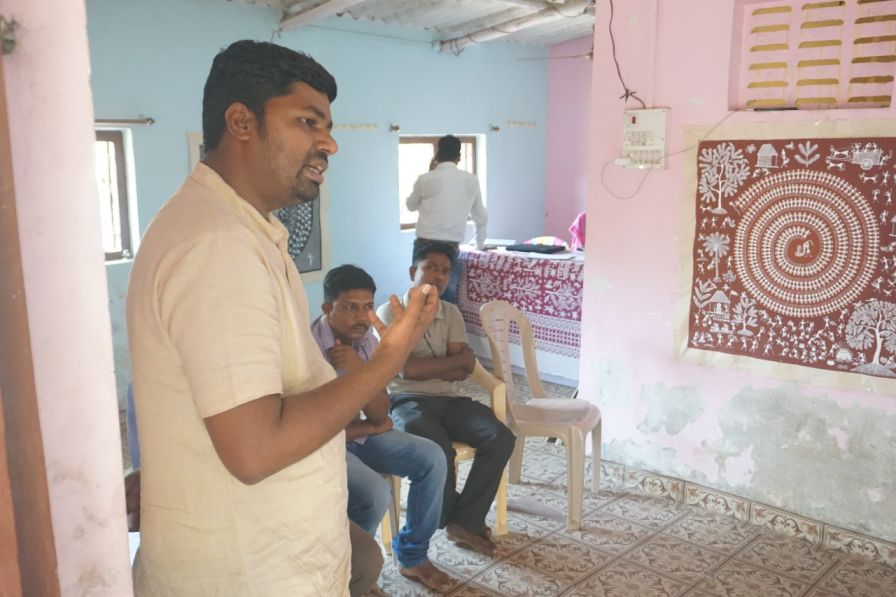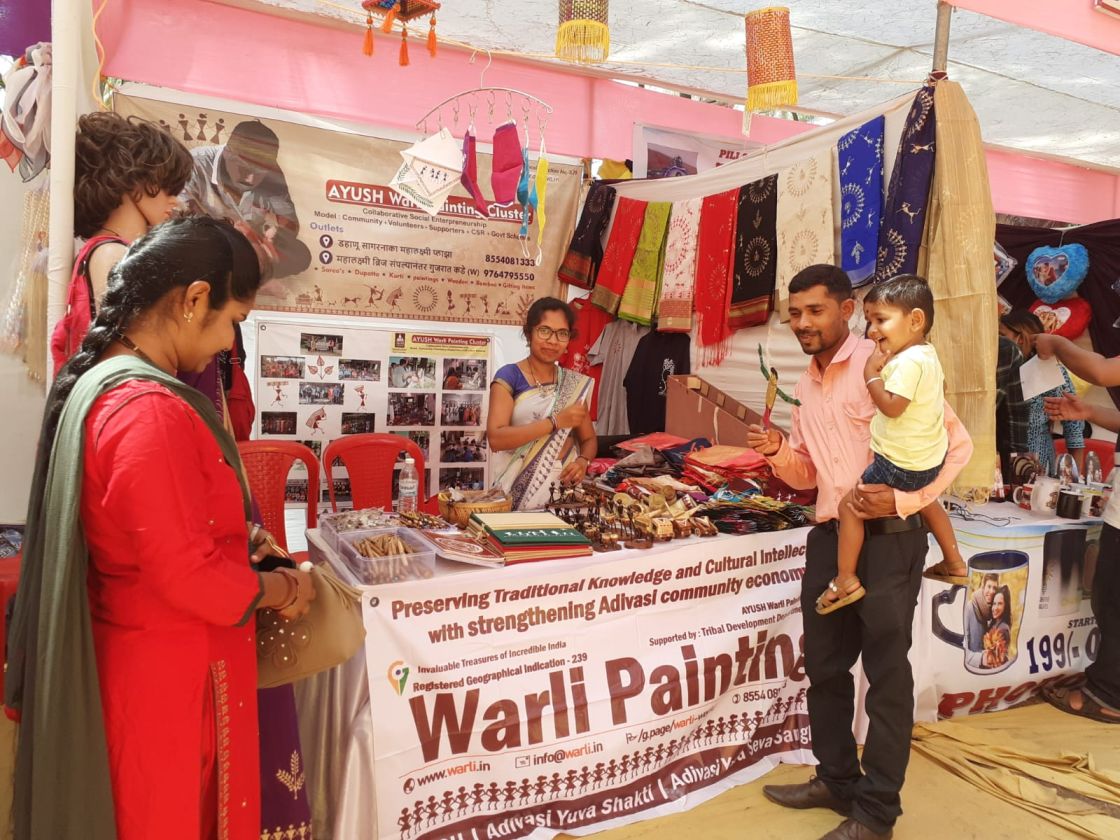Adivasi Women Are Reclaiming Centuries-Old Warli Art With GI-Tags & Huge Murals
Over the years, Adivasi women were sidelined from practising the simple yet beautiful Warli art. Meet the people fighting for the art to be internationally recognised and for more women and youth to earn from its practice.

It was predominantly an art made by women. Simple art consisting of circles, triangles, lines and dots. All arranged differently and only in white, either on red background of geru (red clay) or greenish brown of cow dung smeared on the walls. They sketched when they were happy when there was a birth, a wedding or death in the family. These women took up their ‘brush’ and ‘paints’ to draw sowing paddy, when it rained, when they harvested, when a snake or a tiger entered their fields, when they worshipped or when they celebrated.
They are the Adivasis of Warli, and their art has come to be known as Warli art. Originally hunter-gatherers, the former nomads, have now settled on the Western coasts of Maharashtra and Gujarat states. Forests lands in talukas like Jawahar, Palghar, Dahanu, Nashik, etc. have padas (hamlets) of the Warlis.
For thousands of years, it was Warli women who painted mud walls of their bamboo houses with everyday events of their lives. In her book, The painted world of the Warlis, art historian Yashodhara Dalmia says that the tradition of Warlis goes back to 2500 BCE or 3000 BCE and that their paintings are similar to those found in the Rock Shelters in Bhimbetka, in Madhya Pradesh which were said to be around 500 BCE to 10,000 BCE. But there are no records of this claim. The general belief is that this art originated somewhere in the 10th century AD.
For Warli women, both the inner and outer walls of their bamboo huts form the canvass. And their ‘brushes’ were made from thin portions of a particular type of bamboo growing around their homes in the forests. ‘Paints’ were home-ground rice flour soaked in water. For binding, the flour paste to the mud walls naturally found tree gum was added.
The love for nature, God and family were drawn in simple images by women. The most important drawing of Warli is the Chowk, especially on the occasion of a wedding or an important holy festival. In fact, even today, no marriage ceremony begins without the first drawing of a Lagin Chowk (the wedding square). And this has to be done by savasinis (married women) to the accompaniment of soulful singing by dhavaleri (widowed women who are recognised as a priestess). At the time of other festivals, the Dev Chowk is drawn in the same way.
Though Chowks form the main art, there are other events which are also drawn on the entire walls. And these wall murals can be drawn by anyone.
“We write the Chowk, we don’t draw,” emphasises the over 70-year-old Santi Wangal Varta, a dhavaleri talking from her small house in Wagholi, Dahanu taluka. A very cheery woman who is almost blinded by cataracts in both eyes explains that a Chowk is written according to the words of the song that is sung accompanying the event.
“When we sing …. ‘tetha bijesara deva, jyaca bija padala, hota navarica ra deva… (the God of lighting was present, he gave us lighting, he was the God of the bride)’, the savasinis write the sun, light and the figure of the bride. That’s how the Chowk is written.” Regretfully, she adds, “Now I can’t see properly, otherwise I would have written and shown it to you while singing. I wrote more than ten chowks every year for more than three decades.”
Somewhere around the 1970s, this beautiful unfolding of events by women was hijacked by men when Padma Shri awardee the tribal artist Jivya Soma Mashe of Talasari district in Maharashtra, was discovered by the then Handloom Handicrafts Export Corporation officer Bhaskar Kulkarni. It was he who took Mashe’s art to show the then Prime Minister Indira Gandhi. This paved the way for men to step in.
It was easy for men to go out of their homes and show the world the art which they learnt from their women folk. Slowly, in the last three decades or so, Warli art changed hands — from women to men. But surprisingly even today it’s a savasini who has to draw the first line of the Chowk which is later completed by male artists.
“In a way it was good that Jivya Soma Mashe was discovered which helped Warli people and their art get a pan-India and worldwide recognition,” says Sachin Satvi, an engineer, who along with a few other Warli members founded AYUSH (Adivasi Yuva Shakti) and Adivasi Yuva Seva Sangh (Adiyuva) to help empower Warli youth.
Now working as a senior manager at a multinational automotive company in Hyderabad, he still is a beacon of hope to all Warli youngsters.


Sachin, belonging to the Adivasi Warli, realised the problems faced by other students who wanted to pursue higher studies, get accommodation, get jobs, etc. while he was studying for his diploma and later for his engineering degree way back in 1999. It was very difficult for youngsters who come from small Adivasi hamlets to adjust to Mumbai life and get the information they wanted. He and a few of his friends and batchmates, who were also Warlis, realised this lacuna that though the government had made many plans to help the Adivasis, the information hadn’t trickled down. That’s when the story of AYUSH began. As an NGO it was registered in 2011.
The AYUSH team also secured the GI (Geographical Indication) tag for the Warli art by spending more than Rs 5 lakh from their own pockets. But this story dates back to a time when Orkut – a social networking service was still functioning.
Back when the young boys decided to host a page of their organisation with a picture of Warli’s painting as their motif on the now defunct website, they got a notice from Orkut saying that the motif wasn’t registered by them and they couldn’t use it.
“That was a real jolt to us,” recalls Sachin. “Warli art has belonged to us for centuries and we never thought of claiming it. But when we got the notice, we not only took down our page from Orkut but also decided to apply for the GI tag, which we got in 2014.’’
Once they got this established, AYUSH started reinventing Warli art to make it commercially viable for everyone so that along with the survival of art even the artists could earn to survive.
“It was a herculean task to get our women back to painting. The worst part was that for various reasons like migration to cities by parents they had forgotten their art, culture and traditions. We conduct workshops to train them where we teach them the significance of each step. To get them interested we teach them the commercial methods of painting the Warli motifs on saris, bags, wooden lamps and many other commercial products which we sell through our outlet Mahalaxmi located on the Mumbai-Nagpur highway near Dahanu and at handicrafts exhibitions,” explains Punam Chaure, coordinator at AYUSH.
Today, they have more than 350 people trained in the art who are making a living out of Warli painting. Out of which there are 58 women — girls, suvasins and dhavalelris.
Reclaiming Warli art

Two years of the pandemic seems to have helped the resurrection of women Warli artists. Another group, The Dhavaleri, have only women artists. Kirti Nilesh Vartha, one of the founder members of this group who happily calls herself a feminist says, “Since 2019, we managed to train 30 girls in Warli art. Some of them knew how to paint but didn’t know the exact designs, or the meaning behind the motifs. Under the guidance of the young Suchita Kamdi who learnt Warli art from her grandmother, these girls learnt fast and so far we have managed to draw 19 Chowks.”
The all-women team drawing 19 Chowks in two years is very commendable as people had stopped believing that women artists could draw a Chowk. The Dhavaleri group got a boost when they got an opportunity to write a gigantic wall mural on the lobby walls at the Collector Office in Palghar to commemorate International Women’s Day celebration on 8 March 2022.
The group comprised only women who came from different parts of the Palghar district and wrote the large panel within a day.
The uniqueness of this mural is that it shows the importance of Warli women in all aspects of life. It depicts the detailed work of a dhavaleri, suvasini and the soyin who work as midwives and traditional healers and the Talanwali who perform the funeral rites. This might be the first mural of its kind to have depicted the entire life cycle of Warli women. And of course, it was painted with acrylic paint and brushes. This changing of work material is adapted by every folk art for the longevity of the work.
“We first planned it on paper in detail as to who will draw what and at which place on the wall. We are all very happy to have got this assignment for our women’s group,” says Suchita Kamdi. Suchita recalls a time she faced a bit of opposition when she took up writing Chowk from some male artists who were upset that women were gaining back their right to draw.
“Some said our Chowk wasn’t correct. So, I asked them to point out the incorrectness. But now I think we have got back our work. We need to train more women in the art and train them to sing the songs while writing the Chowk, which we are slowly doing,” explains Suchita.
The women were paid Rs 60,000 for this mural instead of the standard Rs 1,200 to Rs 1,500 per Chowk. Whereas known male artists who are invited to draw the Chowk get paid considerably more to the tune of Rs 5,000 to Rs 10,000 plus.
Hopefully, this will help women claim their rightful place in the world of Warli art. If you found our stories insightful, informative, or even just enjoyable, we invite you to consider making a voluntary payment to support the work we do at The Better India. Your contribution helps us continue producing quality content that educates, inspires, and drives positive change. Choose one of the payment options below for your contribution- By paying for the stories you value, you directly contribute to sustaining our efforts focused on making a difference in the world. Together, let’s ensure that impactful stories continue to be told and shared, enriching lives and communities alike. Thank you for your support. Here are some frequently asked questions you might find helpful to know why you are contributing?

Edited by Yoshita Rao
Sources:
This story made me
-
97
-
121
-
89
-
167












